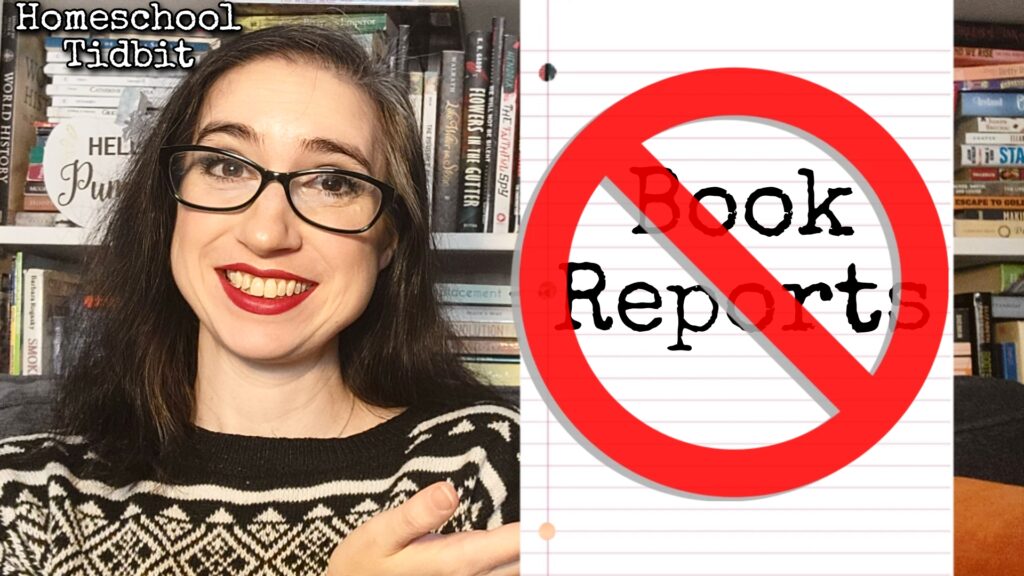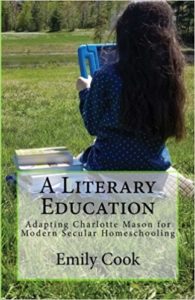Homeschool Tidbits: What to Do Instead of Book Reports
March 3, 2023

Welcome to Build Your Library’s “Homeschool Tidbits: Episode 44 – What to Do Instead of Book Reports”. In this weekly video series, I will delve briefly into a topic related to homeschooling and will share some of my knowledge and expertise as a long-time homeschooling mother of 4 children. Three of whom have graduated high school and one who is a college graduate!
Do you remember back when you were in school and book reports were a thing? Maybe you had to write them once a week, or once a month. Maybe the books were chosen for you or you were allowed to read whatever you wanted. It was a pretty basic format, but no doubt got rather repetitive. You basically just answered a few basic questions – what was the story about? What did you like about it? What didn’t you like?
I don’t know about you, but I despised writing book reports. I love to read, but I didn’t like when teachers turned it into work. Just let me read a story and enjoy it! Having to write a paper every time I read something really sucked the joy out of it.
If you are new to homeschooling, or maybe even if you’ve been at it for a while, you might be wondering when you should start assigning book reports to your kids? Well, I’m here to tell you that that time is never. Don’t do it. Talk about the book together, and have rich discussions, absolutely. But don’t turn it into a tedious assignment that will remove all of the joy out of reading for your children.
Alternative Prompts
However, I know that sometimes we do want to do more with a story. Or maybe you need to have work samples to include in a portfolio. So if that is the case, I’m going to share 20 alternatives to book reports you should do instead.
1. Imagine this book was going to be adapted into a movie and design a movie poster including who you would cast in the movie.
2. Make a music playlist to accompany the book. Include songs that you feel are inspired by the main characters.
3. Write an email to the author of the book telling them what you loved about their story (you don’t have to actually send it).
4. Illustrate a favorite scene from the story.
5. Write a chapter from a different character’s perspective.
6. Create a new dust jacket for the book – they need to design the cover art, write a short synopsis of the story, and include a brief biography of the author. They can even add their own blurb!
7. Design a board or card game based on the book.
8. Film a video review!
9. Create a graphic novel or comic strip of a favorite scene or chapter.
10. Design a bookmark with a favorite quote from the book on one side and an illustration on the other.
11. Keep a fun reading journal that you both add to as you read together. This makes it more like a book club project than a school assignment!
12. Write a poem inspired by the book.
13. Write a journal entry in the voice of your favorite character – choose a favorite scene and have them write their thoughts about what happened!
14. Interview a character. Write out a list of questions about their motivations, their choices, and what they plan to do next. Then they must answer in the voice of that character!
15. Act out a scene using items from around the house as props.
16. Create a memory box and include things that remind you of the story.
17. Write a quiz based on the book for a parent or sibling to take.
18. Play story charades and act out characters and scenes from the story.
19. Build a scene in Minecraft.
20. Write a biography about a favorite character.
Pick 1 activity, or pick 3 depending on how much work is involved in the project. All of these activities adhere to the intent of traditional book reports, such as proving the reader was paying attention to details, understood what was happening, and is able to provide a summary of various ideas presented, etc. But part of homeschooling is giving our children the opportunity to cultivate a love of learning. By giving them non-standard options to explore the books they read in creative ways, we will keep them from becoming bored and uninspired by cookie-cutter book reports.
Tell me in the comments below, what is a fun way you respond to literature in your homeschool!
Coming up next…
I hope you found this Tidbit helpful! Come back next week for more homeschooling inspiration!
Until then, happy reading!
See Other Related Articles:
- Happy, Hygge Homeschooling?
- “Are worms made out of metal?” And other great rabbit trails.
- Charlotte Mason in the Secular Homeschool
- A Literary Education book
- About Build Your Library
- Homeschool Tidbits: Build Your Library’s Weekly Video Blog Series
.
 Emily Cook is the author and creator of the secular homeschool curriculum Build Your Library, a literature-based K-12 program infused with the teachings of Charlotte Mason. She writes full-year lesson plans as well as shorter topical unit studies. Emily has been homeschooling her four children in Southern NH for 21 years. She is passionate about reading aloud to children of all ages and loves to share her love of literature with others. She and her family also make incredibly dorky videos about homeschooling, books, and more on Youtube at ARRRGH! Schooling. You can follow her on Facebook, Twitter, and Pinterest. You can also check out her author page on Amazon.
Emily Cook is the author and creator of the secular homeschool curriculum Build Your Library, a literature-based K-12 program infused with the teachings of Charlotte Mason. She writes full-year lesson plans as well as shorter topical unit studies. Emily has been homeschooling her four children in Southern NH for 21 years. She is passionate about reading aloud to children of all ages and loves to share her love of literature with others. She and her family also make incredibly dorky videos about homeschooling, books, and more on Youtube at ARRRGH! Schooling. You can follow her on Facebook, Twitter, and Pinterest. You can also check out her author page on Amazon.

Wow that’s such a creative list! I’ve determined that Book reports we’re gonna be our house currency when our children get to 1st grade. Now I’m completely scrapping that (still have time) and completely utilizing your ideas. Thanks for sharing! And you’re right I mostly did book reports for the personal pan pizza from Pizza Hut lol